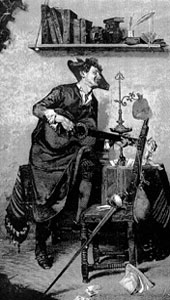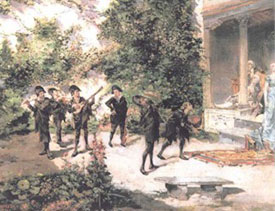1.
Origin.
To discover the true origins of the Tuna, although not in the sense in which we now know it, we have to go back to the very earliest university students in Spain. The first Spanish universities were established in Palencia (1184), Salamanca (1218), Valladolid, Lérida and Santiago de Compostela. The first university in Murcia was the Centro de Estudios Superiores (Centre of Higher Studies) which was founded in 1272 by Alfonso X, the learned king who lived in the city and whose heart is depicted on the coat of arms of Murcia. The same Alfonso X, known as El Sabio (the wise king), referred to the sopistas in the Partidas (official documents) describing them as scholars who played musical instruments as a means of supporting themselves.
These students came to the university cities with scant economic resources and in order to survive and keep themselves they had to rely on their guile, talent and artistic skills. They followed in the tradition of minstrels and troubadours from earlier ages and they also styled themselves on actors and artists of the time.
These poor students became known as sopistas as without enough money to feed themselves, they were forced to rely on the charity offered at monasteries and convents, where they were given sopa boba (the name of the soup given to those who live off the charity of others). There are many stories which depict these students as characters who lived by their wits, and inevitably this often led to clashes with local figures of authority. This was largely due to the hard times in which they lived and because they were known for their tendency for correr la tuna (living it up and having a good time).
When it was time for university holidays, these students formed into groups, according to which part of Spain they were from, and they performed in the towns and villages which they passed through on their way home. This is another meaning of the expression correr la tuna.
These students, who were the forerunners to the tunas as we now know them, didn't dress in the same style as their modern-day counterparts. This is because at that time it was obligatory for all students to wear a gown and a long cloak as well as a hat, of which the most common was a bigornio. They played instruments such as the guitar, the flute, the lute and the tambourine which were the most typical at the time and they performed many different types of music, amongst which we can find records of popular songs of the age, serenades, ballads and even songs which they merely improvised.
In his book Viaje por España (1862) (Travels round Spain), the French author Jean Charles de Davillier makes reference to the tuna in the chapter which deals with Alcalá de Henares:
"Since we find ourselves in a city which has formerly been celebrated for its university, we must make note of these characters who are amongst the most colourful that old Spain has to offer. By this, we mean those students who are commonly known as estudiantes tunantes or de la tuna ...... The classic picaresque novels are full of accounts of their escapades, of which there are countless examples, as it seems that these Spanish students devoted themselves to little else but the pursuit of pleasure.
There is more than one similarity between the lives of these students of the tuna and the ancient roaming knights as well as the minstrels and troubadours of the Middle Ages. Their most popular songs, together with their appearance, show them as being poor and nomadic characters like the former, and poets and musicians like the latter. They commonly sing under windows and balconies and will not think twice about passing round their hat in the hope of receiving a peseta in exchange for their jotas and seguidillas (typical folk songs). They can frequently be found in the company of muleteers, who have even been known to lend them their mounts, as they are also the type of people who can often be found on the open road."
2.
 The end of the original tradition The end of the original tradition
In his book 'Murcia que se fué', printed in Madrid in 1872, J. Fuentes y Ponte writes about those students who belonged to the tuna in the seventeenth century. He also gives his opinion as to why this ancient tradition had, by his time, come to an end:
|
|
"A new education programme was put into practice in 1836 and this changed the way in which the seminaries, universities and schools were run and led to the closure of two of Spain's most famous universities, those of Salamanca and Alcalá. Since then, students are no longer seen en tuna and all that remains of this great tradition are some groups of students who play and sing jotas or those who during Carnaval collect money in the streets. Furthermore, as a consequence of the Revolution of September 1868, students, whether day pupils, boarders or those on a scholarship, were no longer obliged to wear the customary cloak and gown."
Three factors can together be seen as responsible for bringing the tradition of correr la tuna to an end. Firstly, the closure of the old and well-known universities of Alcalá de Henares and Salamanca. Secondly, the fact that it was no longer necessary for students to wear any type of uniform and finally, communications were much improved with the advent of a railway network and this made it much easier for students to return home at holiday times.
As J. Fuentes y Ponte writes, the tradition of correr la tuna was revived decades later, thanks to the festivities held at Carnaval, when there were groups who dressed in the style of students from the past and sang the very same songs that they used to sing.
3. The Continuation of the tradition. The Tuna
The origins of the groups formed by universities and faculties that we recognize nowadays as tunas go back to the groups that were formed throughout Spain at the end of the nineteenth century as a means of commemorating this forgotten, yet once important, pastime of correr la tuna. These groups were better organized and they had better command of their musical instruments. Their conduct and reputation was also better as whilst they no longer behaved as badly as the tunas had once done in the past, they did respect the bygone philosophy of the student who was bohemian, crafty and yet, at the same time, gallant.
At this time, the tunas or estudiantinas were formed according to their city or their university and not, as is now the case, according to their degree subject or faculty. The first tuna in Murcia formed in this way was the Tuna Escolar Murciana, which was established in the early twentieth century, and its members belonged to the Universidad Literaria.
The costume that is used by the tuna nowadays is based on that which the tunas adopted in the nineteenth and early twentieth century which in turn was similar to, without ever attempting to be a copy of, the costume worn by tunas in the distant past.
Nowadays, the costume of a tuno consists of a black jacket with slashed sleeves, black calf- length or even shorter trousers (depending on the place), black hose or tights, black shoes, a white shirt, a black cape and a beca (sash), whose colour represents which faculty the tuno belongs to.
The beca, which is normally made of felt, shows where the tuna come from and at which faculty or university they study. Each faculty or university can be recognized by the colour of its beca and, if that were not enough, the coats of arms of aforesaid institutions are also emblazoned on the becas.
The cape is where the tunos nowadays sew both the embroidered ribbons given to them by girls and the shield badges representing the places that they have visited. This is a wholly modern tradition and no equivalent practice was carried out by students in the past.
Students in the past wore a bigornio (a two peaked hat) and while this continues to be a symbol of the tuna, it is not used commonly nowadays. However, we can sometimes see tunos who wear a bigornio with a crossed wooden spoon in memory of the poor students of times gone by.

|





